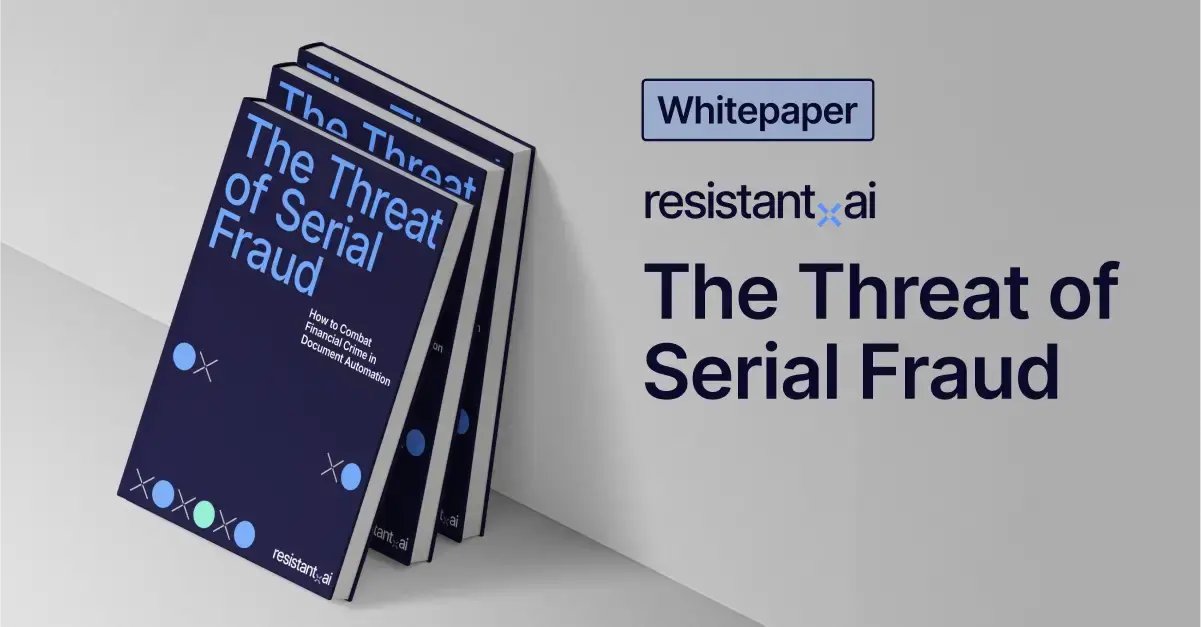How Scribd, Pinterest, Behance and other platforms fuel document fraud



You know we’re all about template farms.
We’ve already identified and catalogued hundreds of online marketplaces focused on providing fake document templates. Whether for a couple bucks or for free, these entities are one of the most serious contributors to the proliferation of document fraud across the global economy.
But fake documents don’t only spread through specialized farms.
There are bigger, much bigger platforms than template farms out there, ones that sometimes host thousands of PDF files and images waiting to be templatized by fraudsters and even farmers themselves.
You likely visit and use some of these platforms on a regular basis.
Pinterest, Scribd, Behance, Issuu, and much more… We’re sure you know at least some of these.
We call them template hubs.
Summary
What is a template hub?
A template hub is a platform that hosts fake documents, but DOES NOT specialize in producing and selling them, whether for free or for profit.
In other words, pretty much any website capable of hosting and providing access to PDF documents or image files can be a template hub.
Before going further into the topic, we also need to make one thing clear – the platforms we are going to mention are leveraged and misused both by fraudsters and by template farmers.
And without further understanding of how these platforms operate in detail, we will not be diving into any assessment as to the legality or otherwise of whether the hosting itself is illegal, or on how such content is being monitored or taken down, or how this could even be done at an efficient and mass scale.
In other words, this is in no way a smear campaign, and the named sites serve many legitimate purposes.
Especially in contrast with template farmers, who clearly specialize in monetizing their presence within the fake document market.
How did we conduct our template hub research?
Within this article, we are going to look at several archetypes of template hubs, specifically:
-
Document libraries
-
Digital publishing platforms
-
Image/creative-focused platforms
-
Academia-focused platforms
Each of these serve different purposes, but they all contain a significant number of documents or images, often of quite decent or even very high quality.
These files can serve as a somewhat viable alternative to template farm offerings, with one obvious caveat – files on these platforms are often accessible for free.
The platforms usually only require account creation or, at most, a fairly inexpensive subscription given the amount of available assets.
What are some of the biggest template hubs?
Imagine any website where you’ve uploaded or shared a document or an image–there’s gonna be a ton.
We focused on sites with a global footprint and website traffic of 5M+ monthly unique visitors — ones that are fairly largely known and have been around for a while.
These are the sites we focused our analysis on:
-
Academia.edu
-
Behance.net
-
Calameo.com
-
Coursehero.com
-
Issuu.com
-
Pinterest.com
-
Scribd.com
-
Studocu.com
-
Yumpu.com
Each of these platforms serves different purposes that fall into the categories we outlined above.
And we will look at each platform individually a bit later.
Now, let’s understand how these platforms raise the threat level for document fraud overall.
How much traffic do these hubs get, and how relevant is this for document fraud?
So, what did we look at specifically with respect to each of the sites listed above?
We tracked and analyzed two aspects: the website traffic and the number of relevant search results on each site, i.e. the number of potentially high-relevance files that could be templatized to commit document fraud.
What are the totals then?
For the 9 platforms listed above, the aggregated total of monthly visits is 1.771 billion.
The number of unique visitors? 648.2 million.
Comparison of monthly web traffic (total visits and unique visitors) of analyzed platforms
These are gigantic numbers. But we need to make one thing clear – the actual percentage of these relevant for our area of expertise, i.e. visitors searching for various documents with the intent of using them for document fraud, will be a tiny, tiny fraction of this.
But let’s say that fraction was something like 0.0001%, i.e., one in every million visits would be relevant to us.
That still makes up for 177,200 monthly visits, and 64,930 unique visitors, respectively, which would place these 9 hubs, in aggregate, amongst some of the most visited template farms we have seen so far.
Not exactly something you can easily disregard. Especially considering this calculation is very basic. Both the actual percentage of relevant visits and the number of existing template hubs could be much higher.
Furthermore, due to their global reach and traffic, template hubs might often serve as some of the first places where fraudsters could look when trying to obtain a specific document.
While many template farms are fairly findable, and have specific reasons for that (as we explained in our articles on Doc Juicer or Utility Bro), locating a specific farm might still require a basic level of understanding of search engines and what to look for.
For many people, simply going to a site they already know and searching there might be the easiest starting point.
With that in mind, what did we actually look for? And what did we find?
Let’s open the template hub document vaults!
9 template hubs, thousands of document templates
Overall, we performed over 150+ different search operations that yielded us over 1.3 million search results.
Comparison of search results of analyzed platforms
Keep in mind that not all of these results will be for malicious document templates we’re talking about. Some will be harmless images that simply match our target keyword. However, even if we took a very conservative approach and said that only 1% of the search results were relevant, this would still amount to almost 14,000 documents or document images in aggregate, easily ranking among the biggest specialized template farms we have seen so far.
For more information on how we got this information, please check the “Methodology” section below.
What document types did we focus on then?
For each template hub, we searched for:
-
Bank statements / account statements
-
Utility bills / proofs of address
-
National IDs
-
Passports
-
Drivers licenses
-
Birth certificates
-
Pay stubs
-
Receipts
-
Invoices
-
Business licenses / Certificates of incorporation
Looking at the distribution of different document types based on the keyword we searched by, the document type with the highest number of search results was, by a landslide, passport, with almost 700k search results.
Comparison of search results for each document type
Why passports?
Passports are one of the most used types of documentation for travel purposes, a globally common theme for content sharing. In that sense, this figure is significantly inflated by the number of search results identified on Pinterest, with thousands of results showing only a passport cover but not the actual inside of the document.
The next most frequent document types are receipts, invoices and ID cards.
This is likely due to two reasons:
-
The wide variety of these document types based on the number of potential issuers and use cases.
-
The dual use of these document type titles, which can be provided both as documents of specific issuers (relevant) or as generic, ready-for-customization templates targeting individuals or small businesses needing these templates for legitimate purposes.
The next batch of searched document types is much more interesting from the standpoint of document fraud, as these are more specific documents search-wise that we often see within production. These are:
-
Bank/account statements,
-
Driving licenses,
-
Birth certificates,
-
Utility bills,
-
Business licenses,
-
Pay stubs.
For each of these, we identified thousands of different search results, with numerous high-quality examples.
These overall search result figures and examples across all analyzed platforms provide us with a helicopter-view understanding of the issue.
But platforms differ. Not just from the standpoint of web traffic or volume of search results, but with respect to accessibility, document quality and the overall “threat level” they represent.
Let’s now quickly look at each platform individually.
Which template hub presents the biggest threat?
As we tried to explain in previous sections, template hubs are an issue as they store thousands of high-quality document files that can be potentially exploited or templatized to be further used to commit document fraud.
However, each of the analyzed platforms differs by primary use case, traffic, volume and quality of content available.
Let’s start with the template hub that presents the biggest threat.
Scribd
Monthly Unique Visitors: 144.1M
Total Search Results: 461,461
Established in San Francisco in 2007, Scribd is a digital library offering a vast collection of documents. Users can access and upload content across various topics, with over 195 million documents available.
Files are primarily in PDF and Word formats, viewable online and downloadable for offline access. However, some contributors may restrict downloads, and file quality varies based on the original upload.
Through our search queries, we identified over 350,000 results, with many being highly relevant.
The same goes for the document quality – these are often high-quality PDF files, the type most suitable for templatization and further generation of more fake documents, either as more PDFs or printing these out and either photographing/scanning these to be used as document images.





Examples of PDFs available on Scribd, including many of the document types we researched
such as bank statements, utility bills, invoices, pay stubs or business licenses
Whether it’s account statements, utility bills, invoices, pay stubs or business licenses, there’s a lot of high-quality examples for each of these document types, and much more.
The combination. of high traffic, high quality and often easy and direct access to downloading of PDFs make Scribd the most dangerous of template hubs.
The threat of academia-focused template hubs
The last group of our list of template hubs includes platforms with a slightly different focus – academia and study materials.
While these hubs differ in their primary focus and use case, we still found
a lot of relevant search results,
Course Hero
Monthly Unique Visitors: 8.8M
Total Search Results: 21,965
Founded in 2006 in Redwood City, California, Course Hero is an online learning platform offering a vast library of course-specific study resources. Students and educators upload documents such as study guides, lecture notes, and practice problems to assist others in their studies.
The platform boasts millions of user-contributed resources across various subjects and institutions. Files are available in formats like PDFs and Word documents.

With document viewing often unavailable without subscription, this HSBC bank statement is one of several examples we were able to access fully, with numerous more results available.
Entry-level file access requires account creation, with most files being available only through paid subscription or via upload of own documents
(a credit system based on the number of uploads).
Studocu
Monthly Unique Visitors: 27.1M
Total Search Results: 13,188
Launched in 2013, Studocu is an online learning platform where students share study resources such as lecture notes, summaries, and other academic documents. The platform hosts over 35 million study resources from more than 115,000 institutions.

Similarly to Course Hero, Studocu also often limits full view of a document without a subscription or upload of own documents, this Amazon invoice being one exception.
Files are primarily in document formats like PDFs and Word files, with quality varying based on the original contributor. Access to files often requires paid subscription or upload of own documents.
Academia
Monthly Unique Visitors: 23.6M
Total Search Results: 4,071
Established in 2008 in San Francisco, Academia is a platform for academics to share research papers. Its primary purpose is to facilitate the dissemination and discovery of scholarly work across various disciplines.
The platform has over 170 million registered users and hosts more than 40 million papers. Files are typically available in PDF format.



Academia provides numerous examples for several document types,
often making these downloadable with a simple account creation.
Unlike Course Hero and Studocu, access to files is usually available upon account registration, i.e. it does not require paid subscription or upload of documents.
Inspecting numerous results, there’s many examples for document types such as invoices, bank statements/references or pay stubs.
Which template hubs do we view as lower-level threats?
Monthly Unique Visitors: 392.5M
Total Search Results: 1,019,748
Founded in 2009 and headquartered in San Francisco, Pinterest is a globally known visual discovery platform where users share and discover images and short videos.
Content is accessible primarily in image formats like JPG and PNG. While users can save and share content within the platform, downloading may be restricted based on the source website's settings.
Pinterest leads our list both in terms of overall web traffic and the volume of search results. However, the relevance of results can vary significantly.
Inspecting specific results, two things seem obvious:
-
Images are easy to download, but usually in a lower quality.
-
Most results function as ads for forgers and farmers rather than being standalone image entries.



Pinterest provides access to millions of images, including receipts,
utility bills or bank statements.
And, of course, there’s one more factor that directly contributes to Pinterest being leveraged to fuel document fraud – content suggestions.
Drawing on the volume of content it makes accessible, finding one relevant result of a document template instantly points you to tens or hundreds of similar results.
While most other template hubs have this feature as well, pairing it with the overall volume of content and web traffic exponentially increases the rate of document purchases or template farm visits Pinterest can enable.
Behance
Monthly Unique Visitors: 19.7M
Total Search Results: 35,823
Founded in 2006 and later acquired by Adobe, Behance is an online platform for showcasing and discovering creative work, with artists and designers uploading portfolios to display their projects.
The platform hosts millions of projects across various creative fields, including graphic design, photography, and illustration. Content is primarily visual, though download options are limited to protect creators' rights.
Our inspection of documented search results shows that, strictly on files itself, the platform is a lower-level threat as image files are often protected with watermarks or other elements allowing for easy download.
Most entries also refer to generic templates not imitating any specific issuer, making these much less relevant for our research purposes.



Behance mostly serves as more of an advertising channel for professional forgers of template farmers rather than a treasure trove of documents. The example above shows the portfolio of "Graphics Hunter", an entity specializing in fake bank statements.
Albeit low-level, the threat level of Behance is increased by a different factor – as the platform is targeting creative professionals to showcase their work, professional document forgers and fake document creators are leveraging the platform to advertise their own services and fake document portfolios.
The aspect of template hubs being used as advertising channels by fake document vendors is another important layer of the issue (and one we will talk more about a bit later).
Issuu
Monthly Unique Visitors: 18.2M
Total Search Results: 29,265
Launched in Copenhagen, Denmark, in 2006, Issuu is a digital publishing platform for magazines, catalogs, and any other publications.
Issuu enables users to upload and share content globally, with files typically available in high-quality PDF format. However, access to content may require a subscription, and publishers often don’t allow direct download of uploaded documents.



With access to document download often limited, Issuu functions more as an advertising platforms for farmers than a direct source of high-quality documents. That being said, entries vary and there’s relevant search results for pay stubs, utility bills, bank statements, and more.
Issuu is not anywhere close to Scribd in terms of traffic or search result volume, and users often do limit the ability to download documents.
On the other hand, we have seen numerous search results on the platform being used as advertisements for actual template farms, which factors in when assessing the platform as a hub fueling the spread of the fake document market.
Yumpu
Monthly Unique Visitors: 7.9M
Total Search Results: 6,528
Originating in Austria, Yumpu allows users to publish and share digital magazines and brochures. Its main function is converting PDFs into interactive online publications that can be easily shared and embedded on websites.
Quite similar to Issuu, Yumpu is a much smaller platform with less than half of the traffic and about a fifth of search results.
Files are available for viewing and download, with quality dependent on the original upload.



While potentially containing numerous outdated documents, we identified various document types on Yumpu including certificates of incorporation, invoices or bank statements.
Based on our inspection of identified results, it seems that a lot of documents uploaded on the platform have been lying there for years (mostly pre-2020), indicating that documents could be outdated. Downloading of documents requires account creation, with some publishers disabling the option similarly to other platforms.
Calameo
Monthly Unique Visitors: 6.3M
Total Search Results: 1,060
Founded in France in 2008, Calameo is a digital publishing platform that transforms documents into interactive publications. Users can upload content such as magazines, brochures, and reports, making them accessible online.
Files are viewable online, with the option to download often limited by publishers even with a created account.



Very similar to Issuu or Yumpu (but yet smaller), Calameo hosts some relevant document types
such as birth certificates, receipts or inovices.
After inspecting identified results, Calameo is clearly a smaller and somewhat less relevant alternative to Issuu or Yumpu.
As with the other hubs mentioned in this section, a significant part of identified results focus more on advertising of forgers and farmers rather than providing high-quality documents right off the bat.
That being said, the advertising aspect of template hubs is an issue in itself.
Template farmers and forgers use hubs as advertising space
So far, you’ve seen what kinds of platforms can be leveraged and misused as template hubs and some examples of what they’re offering.
But aside from the document files and images themselves, these hubs seem to have one more relevant use case. Especially for template farmers and professional document forgers.
From what we’ve seen, at least some of the farmers we’ve already identified leverage template hubs as advertising channels for their hand-crafted fraud services.
This is an important layer to our overall threat assessment of template hubs.
While some of the mentioned platforms do not provide direct access to high-quality documents or their images, containing hundreds to thousands of ads and links to specialized template farms directly contributes to the spread of the fake document market.
Aside from all the other advertising tactics we’ve described in some of our previous articles, farmers naturally try to take advantage of the much more significant volume of traffic template hubs get as opposed to farm websites themselves.
One representative example?
We specifically looked at the advertising efforts of Doc Juicer, who maintains its presence on all of the template hubs listed above.
What does the advertising look like?
While we’re not gonna show you specific examples here to avoid giving the Juicer yet more traction and visibility, the advertising has several main types and features:
-
Grid-like images/ads uploaded as a single file to show the variety of the Juicer’s offering (of course, with specific farm URL).
-
A single document ad, providing a closer look at the document, overlaid with watermarks referring to the Juicer’s websites.
-
Details on template quality, formats and editability taken from the farm website itself.
-
Link to the profile of the uploading account/entity, usually with the same name as the farm website.
In some cases, accounts that might not belong to the Juicer himself are advertising some of his templates, potentially being former satisfied customers providing referrals.
For our threat intel operations, these advertising entries are quite valuable. They point us to more farms we haven’t yet identified. As we keep reiterating, the farm list only keeps growing.
Key insights and lessons
There are several key lessons to take from template hubs:
-
TEMPLATE HUBS ARE AN ISSUE, THOUGH NOT AS BIG AS TEMPLATE FARMS
Unlike dedicated template farms that exist solely to produce and distribute fake documents, template hubs serve broader, often legitimate purposes. However, their ability to host large volumes of PDF files and images makes them a useful resource for fraudsters looking for high-quality materials. - HIGH-QUALITY DOCUMENTS ARE AVAILABLE FOR FREE OR A FAVOURABLE, CHEAP SUBSCRIPTION
High-quality document templates aren’t always hidden behind paywalls or exclusive networks.Many template hubs provide free or low-cost access to files that fraudsters can exploit, requiring nothing more than a simple account registration or a small subscription fee.
-
EVEN CONSERVATIVE ESTIMATES REVEAL A SIGNIFICANT DOCUMENT-FRAUD-RELATED THREAT
The sheer scale of template hubs cannot be ignored. Our analysis showed that the nine template hubs we examined collectively receive over 1.7 billion visits per month.Even if only a minuscule fraction of these visits are fraud-related, the absolute numbers remain significant.
- TEMPLATE HUBS ARE ACTIVELY USED AS ADVERTISING CHANNELS BY DOCUMENT FORGERS AND TEMPLATE FARMERS
Some template hubs are leveraged by professional forgers and template farmers as promotional spaces. Fraudsters strategically upload fake document samples with embedded watermarks, URLs, and other references to direct potential buyers to their full template catalogs.
As we try to demonstrate with all of our threat intel articles, the fake document ecosystem is vibrant. Realistically, it can only grow in both the size and the sophistication of templates.
It is vital to consider integrating advanced document verification and fraud detection technology into your company’s processes.
At Resistant AI, we continuously monitor template hubs to understand their evolving role in the document fraud ecosystem. We track the availability, quality, and distribution of templates across these platforms, staying ahead of fraudsters and combatting emerging risks.
Look no further than our very own Resistant Documents solution, to show how we use this intel to detect and prevent document fraud on a daily basis.
Methodology
For the purposes of this article, we focused on the main document/template types that we see most frequently, both within production and our threat intelligence research.
To further narrow our search queries and focus on the most relevant results, we decided to only look for files that contain the document type within the listed file title itself using the “intitle” search operator.
For example, searching for any results containing the term “bank statement” would likely yield a lot of false positives, i.e. irrelevant documents/images not suitable for templatization.
But when you only focus on files specifying “bank statement” in the file name/title itself, chances are much higher that this will be a relevant entry.
However, relevance is not guaranteed though. Individual entries still have to be inspected to make a proper assessment on the relevance of any given search result.
Keep in mind: The stats provided here refer to search results for specific websites rather than the actual number of relevant files (documents or images) — as we have done in the past with template farms.
This has three important limitations:
-
The actual number of templates on a given site might be significantly lower due to the fact that some search results don’t refer to an actually useful file, even if the search keyword (document type) is contained in the title of the identified page/item,
-
The actual number of templates on a given site might also be higher as not all entries on a given hub might be properly indexed by the search engine used (Google),
-
Some search results might refer to more than just one template. I.e., there are cases when the indexed page refers to a collection of templates rather than just one individual template.







